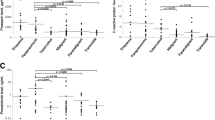Abstract
The aim of this study was to determine whether pleural fluid C-reactive protein (CRP) is useful in distinguishing complicated parapneumonic pleural effusion (CPPE) and empyema from uncomplicated parapneumonic pleural effusions (UPPE). A total of 69 consecutive patients with parapneumonic effusions were enrolled in the study: 29 with UPPE, 29 with CPPE, and 11 with empyema. Concentrations of standard biochemical parameters together with CRP in the pleural fluid were measured using an immunoturbidimetric assay. Pleural CRP was significantly higher in CPPE (11.6 mg/dl) and in empyema (12.2 mg/dl) than in UPPE (3.9 mg/dl). A cutoff value of 8.7 mg/dl for pleural CRP in the diagnosis of CPPE and empyema resulted in a sensitivity, specificity, and area under the receiver-operating characteristic curve (AUC) of 0.80, 0.97 and 0.94, respectively. Traditional lactic dehydrogenase (LDH) ≥ 1000 U/L and glucose ≤ 60 mg/dl can differentiate CPPE and empyema from UPPE, with the sensitivity, specificity, and AUC achieving 0.75/0.60.1.00/1.00,0.95/0.22, respectively. However, for the detection of CPPE and empyema, the combination of pleural fluid CRP ≥ 8.7 mg/dl and LDH ≥ 1000 U/L was valuable in achieving a sensitivity, specificity, and AUC of 0.97/1,00/0.95. This study suggests that measurement of pleural CRP can be useful in the workup of patients with a parapneumonic effusion in order to differentiate CPPE from UPPE.


Similar content being viewed by others
References
Alexandrakis MG, Coulocheri SA, Bouros D, et al. (2000) Evaluation of inflammatory cytokines in malignant and benign pleural effusion. Oncol Rep 7(6):1327–1332
Castano Vidriales JL, Amores Antequera C (1992) Use of pleural fluid C-reactive protein in laboratory diagnosis of pleural effusions. Eur J Med 4:201–207
Chapman SJ, Davies RJ (2004) The management of pleural space infections. Respirology 9(1):4–11
Colice GL, Curtis A, Deslauriers J, et al. (2000) Medical and surgical treatment of parapneumonic effusions: an evidence-based guideline. Chest 118:1158–1171
Garcia–Pachon E, Llorca I (2002) Diagnostic value of C-reactive protein in exudative pleural effusion. Eur J Intern Med 13(4):246–249
Hamm H, Light RW (1997) Parapneumonic effusion and empyema. Eur Respir J 10:1150–1156
Heffner JE (1999) Indications for draining a parapneumonic effusion: an evidence-based approach. Semin Respir Infect 14:48–58
Heffner JE, Brown LK, Barbieri C, et al. (1995) Pleural fluid chemical analysis in parapneumonic effusions. Am J Respir Crit Care Med 151:1700–1708
Hernández L, Romero S (2002) Derrame pleural maligno. In: Porcel JM (ed.) Enfermedades de la pleura. Publisher, City, pp 83–94
José M, Pharm D (2004) Tumor necrosis factor-α in pleural fluid. Chest 125:160–164
Light RW (1995) A new classification of parapneumonic effusions and empyema. Chest 108:299–301
Light RW, Girard WM, Jenkinson SG, et al. (1980) Parapneumonic effusions. Am J Med 69:507–512
Maskell NA, Gleeson FV, Darby M, Davies RJ (2004) Diagnostically significant variations in pleural fluid pH in loculated parapneumonic effusions. Chest 126(6):2022–2024
Odeh M, Sabo E, Oliven A, Srugo I (2000) Role of tumor necrosis factor-alpha in the differential diagnosis of parapneumonic effusion. Int J Infect Dis 4(1):38–41
Ogawa K, Koga H, Kohno S, et al. (1996) [Differential diagnosis of tuberculous pleurisy by the measurement of cytokine concentration in pleural effusion.] Kekkaku 71(12): 663–669
Vives M, Porcel JM, Vicente de Vera M, Ribelles E, Rubio M (1996) A study of Light’s criteria and possible modifications for distinguishing exudative from transudative pleural effusions. Chest 109(6):1503–1507
Vives M, Porcel JM, Gazquez I, Perez B, Rubio M (2000) Pleural SC5b-9: A test for indentifying complicated parapneumonic effusion. Respiration 67:433–438
Yilmaz Turay U, Yildirim Z, Turkoz Y, et al. (2000) Use of pleural fluid C-reactive protein in diagnosis of pleural effusions. Respir Med 94(5):432–435
Author information
Authors and Affiliations
Corresponding author
Rights and permissions
About this article
Cite this article
Chen, S.C., Chen, W., Hsu, W.H. et al. Role of Pleural Fluid C-Reactive Protein Concentration in Discriminating Uncomplicated Parapneumonic Pleural Effusions from Complicated Parapneumonic Effusion and Empyema. Lung 184, 141–145 (2006). https://doi.org/10.1007/s00408-005-2573-0
Accepted:
Issue Date:
DOI: https://doi.org/10.1007/s00408-005-2573-0



